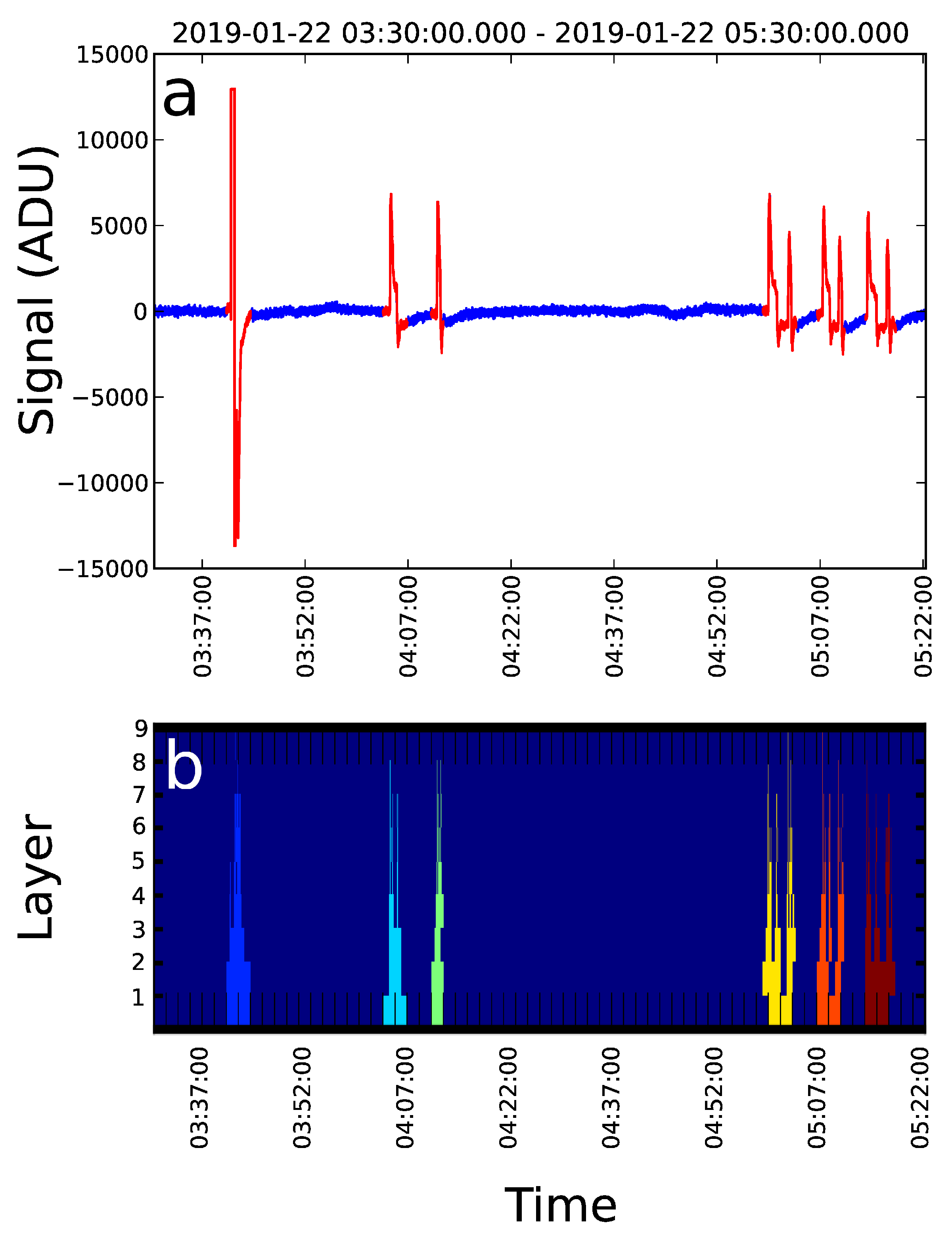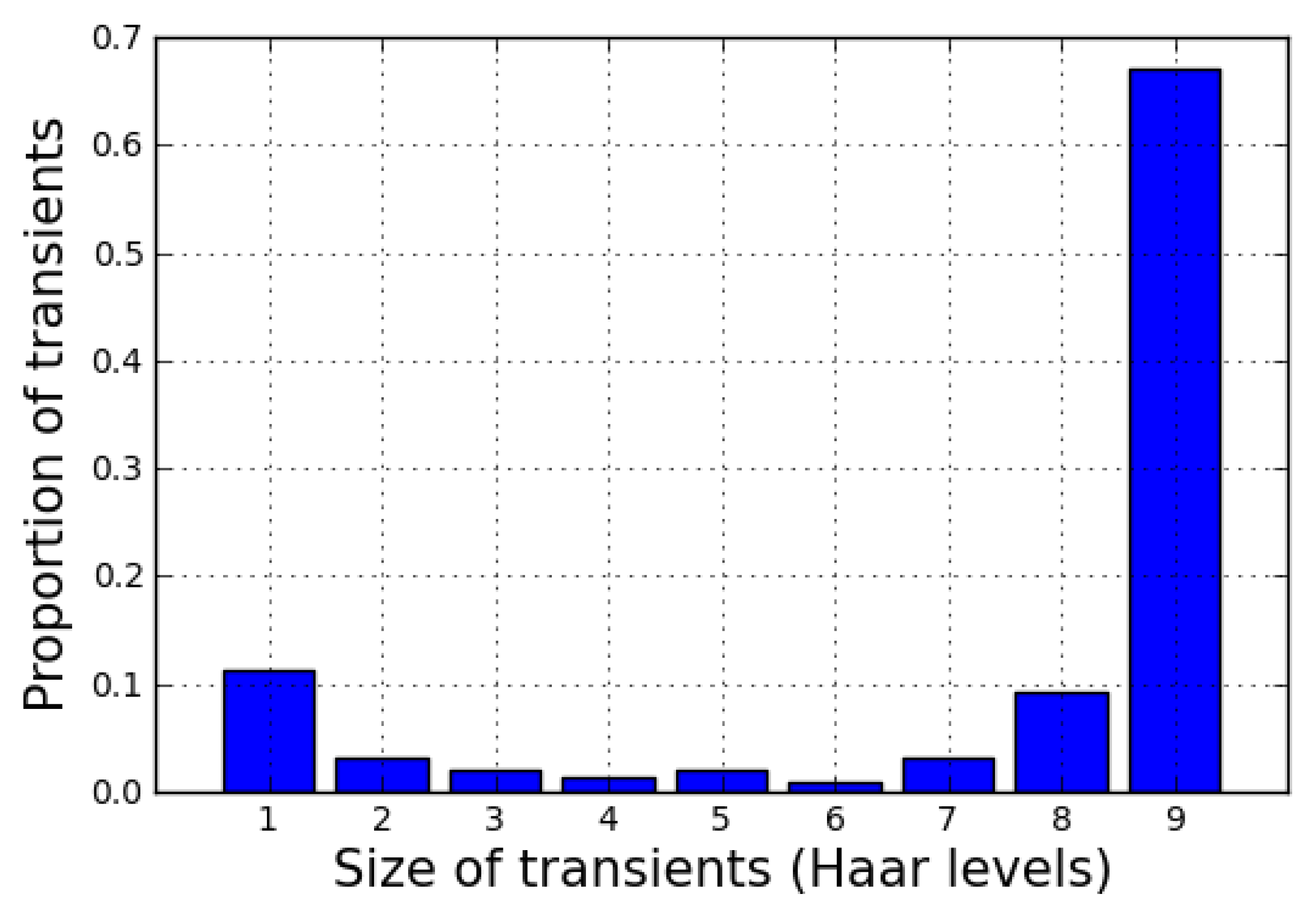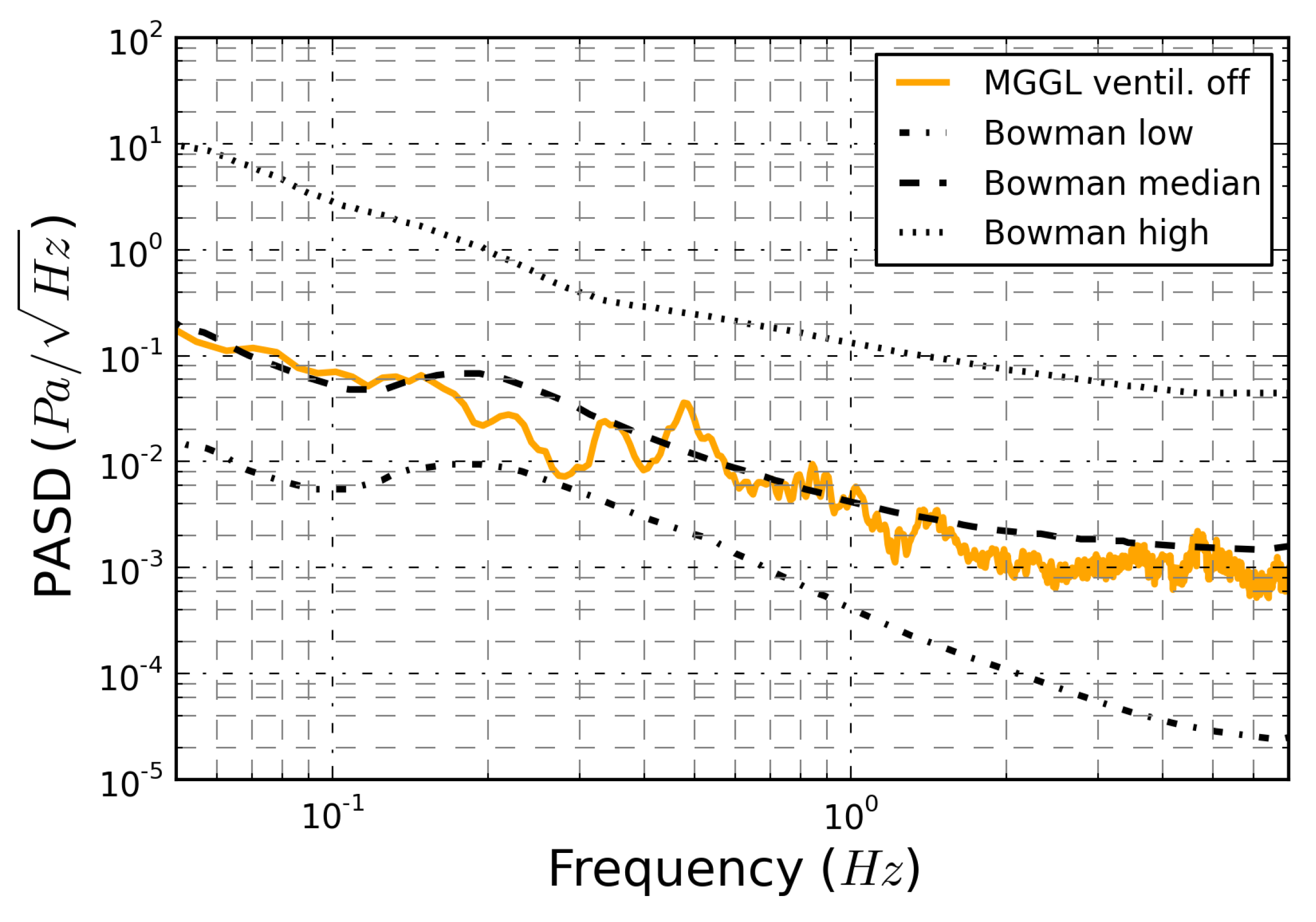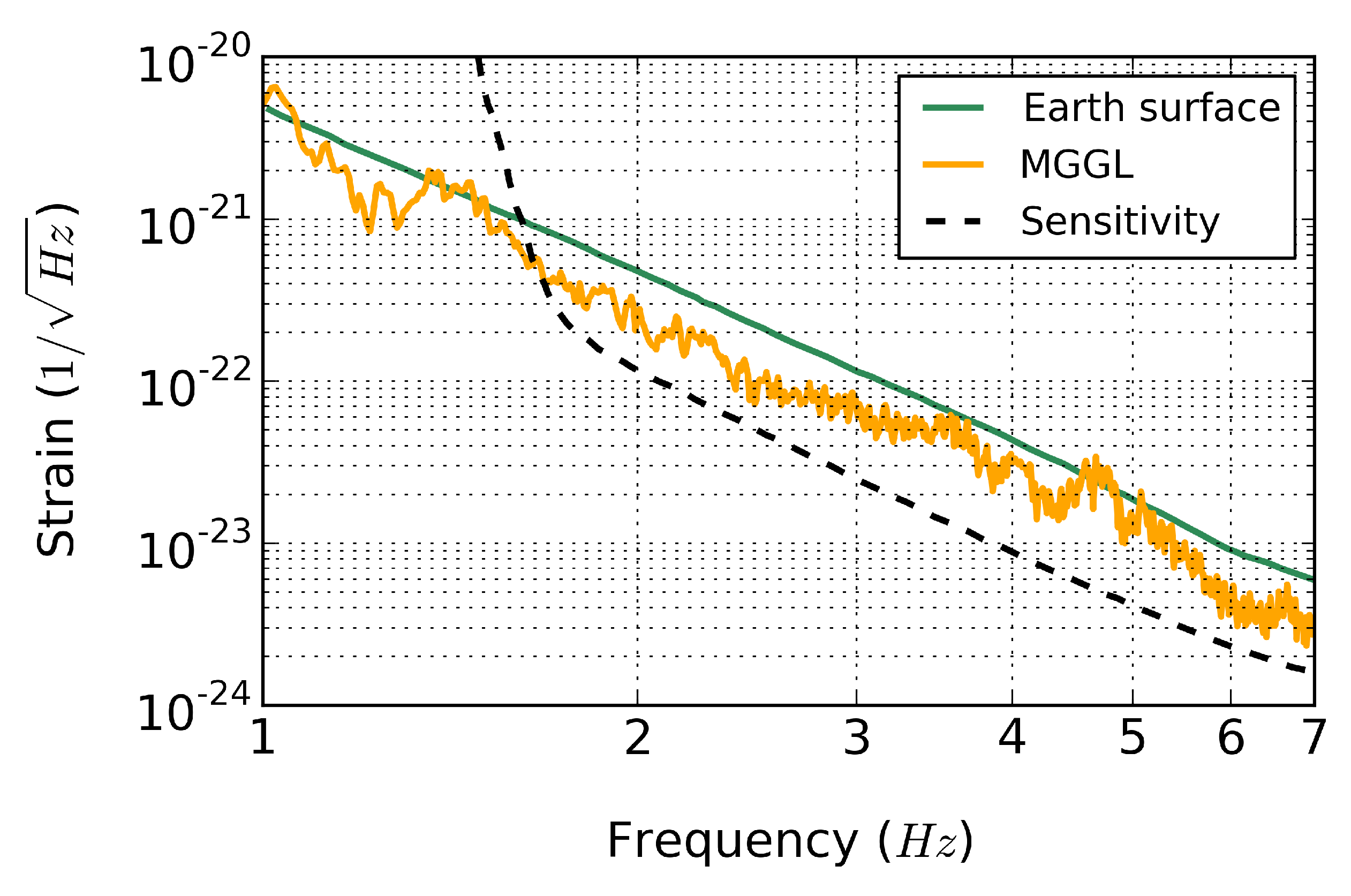Investigation of Infrasound Background Noise at Mátra Gravitational and Geophysical Laboratory (MGGL)
Abstract
1. Introduction
2. Materials and Methods
2.1. Data Collecting
2.2. Data Processing
2.2.1. Finding Transients
2.2.2. Computing Representative Spectra
3. Results of Investigating Infrasound Background Noise at MGGL
3.1. Statistical Analysis of Transients in the Haar Wavelet Domain
3.2. Effect of Removing Data Segments Corrupted by Transients on the Representative Pressure Amplitude Spectral Density (PASD)
3.3. Investigation of the Sources of the Continuous Background Infrasound Noise at MGGL and Comparison with the Bowman Models
4. Estimating the Contribution of Infrasound Newtonian Noise to the Strain Noise of a Subterranean Gravitational Wave Detector
5. Conclusions
Author Contributions
Funding
Acknowledgments
Conflicts of Interest
References
- Abbott, B.P.; et al. [LIGO Scientific Collaboration and Virgo Collaboration]. Observation of Gravitational Waves from a Binary Black Hole Merger. Phys. Rev. Lett. 2016, 1166, 061102. [Google Scholar] [CrossRef]
- Abbott, B.P.; et al. [LIGO Scientific Collaboration and Virgo Collaboration]. GW151226: Observation of Gravitational Waves from a 22-Solar-Mass Binary Black Hole Coalescence. Phys. Rev. Lett. 2016, 116, 241103. [Google Scholar] [CrossRef]
- Abbott, B.P.; et al. [LIGO Scientific Collaboration and Virgo Collaboration]. GW170104: Observation of a 50-Solar-Mass Binary Black Hole Coalescence at Redshift 0.2. Phys. Rev. Lett. 2017, 118, 221101. [Google Scholar] [CrossRef]
- Abbott, B.P.; et al. [LIGO Scientific Collaboration and Virgo Collaboration]. GW170608: Observation of a 19 Solar-mass Binary Black Hole Coalescence. Am. Astron. Soc. 2017, 851, L35. [Google Scholar] [CrossRef]
- Abbott, B.P.; et al. [LIGO Scientific Collaboration and Virgo Collaboration]. GW170814: A Three-Detector Observation of Gravitational Waves from a Binary Black Hole Coalescence. Phys. Rev. Lett. 2017, 119, 141101. [Google Scholar] [CrossRef]
- Abbott, B.P.; et al. [LIGO Scientific Collaboration and Virgo Collaboration]. GW170817: Observation of Gravitational Waves from a Binary Neutron Star Inspiral. Phys. Rev. Lett. 2017, 119, 161101. [Google Scholar] [CrossRef]
- Abbott, B.P.; et al. [LIGO Scientific Collaboration and Virgo Collaboration]. Multi-messenger Observations of a Binary Neutron Star Merger. Astrophys. J. 2017, 848, L12. [Google Scholar] [CrossRef]
- Abbott, B.P.; Abbott, R.; Abbott, T.D.; Acernese, F.; Ackley, K.; Adams, C.; Adams, T.; Addesso, P.; Adhikari, R.X.; Adya, V.B.; et al. Gravitational Waves and Gamma-Rays from a Binary Neutron Star Merger: GW170817 and GRB 170817A. Astrophys. J. 2017, 848, L13. [Google Scholar] [CrossRef]
- Goldstein, A.; Veres, P.; Burns, E.; Briggs, M.S.; Hamburg, R.; Kocevski, D.; Wilson-Hodge, C.A.; Preece, R.D.; Poolakkil, S.; Roberts, O.J.; et al. An Ordinary Short Gamma-Ray Burst with Extraordinary Implications: Fermi-GBM Detection of GRB 170817A. Astrophys. J. 2017, 848, L14. [Google Scholar] [CrossRef]
- Savchenko, V.; Ferrigno, C.; Kuulkers, E.; Bazzano, A.; Bozzo, E.; Brandt, S.; Chenevez, J.; Courvoisier, T.J.-L.; Diehl, R.; Domingo, A.; et al. INTEGRAL Detection of the First Prompt Gamma-Ray Signal Coincident with the Gravitational-wave Event GW170817. Astrophys. J. 2017, 848, L15. [Google Scholar] [CrossRef]
- Bartos, I.; Kowalski, M. Multimessenger Astronomy; IOP Publishing: Bristol, UK, 2017; ISBN 978-0-7503-1369-8. [Google Scholar]
- Krauss, L.M.; Dodelson, S.; Meyer, S. Primordial Gravitational Waves and Cosmology. Science 2010, 328, 732–736. [Google Scholar] [CrossRef]
- Saulson, P.R. Terrestrial gravitational noise on a gravitational wave antenna. Phys. Rev. D 1984, 30, 989–992. [Google Scholar] [CrossRef]
- Harms, J. Terrestrial gravity fluctuations. Living Rev. Relativ. 2019, 22, 6. [Google Scholar] [CrossRef]
- Ballmer, S.; Mandic, V. New Technologies in Gravitational-Wave Detection. Annu. Rev. Nucl. Part. Sci. 2015, 65, 555–577. [Google Scholar] [CrossRef]
- Fiorucci, D.; Harms, J.; Barsuglia, M.; Fiori, I.; Paoletti, F. Impact of infrasound atmospheric noise on gravity detectors used for astrophysical and geophysical applications. Phys. Rev. D 2018, 97, 062003. [Google Scholar] [CrossRef]
- Coughlin, M.; Harms, J.; Christensen, N.; Dergachev, V.; DeSalvo, R.; Kandhasamy, S.; Mandic, V. Wiener filtering with a seismic underground array at the Sanford Underground Research Facility. Class. Quantum Gravity 2014, 31, 215003. [Google Scholar] [CrossRef]
- Coughlin, M.W.; Harms, J.; Driggers, J.; McManus, D.J.; Mukund, N.; Ross, M.P.; Slagmolen, B.J.J.; Venkateswara, K. Implications of Dedicated Seismometer Measurements on Newtonian-Noise Cancellation for Advanced LIGO. Phys. Rev. Lett. 2018, 121, 221104. [Google Scholar] [CrossRef]
- Badaracco, F.; Harms, J. Optimization of seismometer arrays for the cancellation of Newtonian noise from seismic body waves. Class. Quantum Gravity 2019, 36, 145006. [Google Scholar] [CrossRef]
- Akutsu, T.; Ando, M.; Arai, K.; Arai, Y.; Araki, S.; Araya, A.; Aritomi, N.; Asada, H.; Aso, Y.; Atsuta, S.; et al. KAGRA: 2.5 generation interferometric gravitational wave detector. Nat. Astron. 2019, 3, 35–40. [Google Scholar] [CrossRef]
- Abernathy, M.; et al. [ET Science Team]. Einstein Gravitational Wave Telescope Conceptual Design Study. Available online: http://www.et-gw.eu/index.php/etdsdocument (accessed on 29 December 2019).
- Beker, M.; van den Brand, J.; Rabeling, D.S. Subterranean ground motion studies for the Einstein Telescope. Class. Quantum Gravity 2015, 32, 025002. [Google Scholar] [CrossRef]
- Barnaföld, G.G.; Bulik, T.; Cieslar, M.; Dávid, E.; Dobróka, M.; Fenyvesi, E.; Gondek-Rosinska, D.; Gráczer, Z.; Hamar, G.; Huba, G.; et al. First report of long term measurements of the MGGL laboratory in the Mátra mountain range. Class. Quantum Gravity 2017, 34, 114001. [Google Scholar] [CrossRef]
- Ván, P.; Barnaföldi, G.G.; Bulik, T.; Biró, T.; Czellár, S.; Cieślar, M.; Czanik, C.; Dávid, E.; Debreceni, E.; Denys, M.; et al. Long term measurements from the Mátra Gravitational and Geophysical Laboratory. Eur. Phys. J. Spec. Top. 2019, 228, 1693–1743. [Google Scholar]
- Bowman, J.R.; Baker, G.E.; Bahavar, M. Ambient infrasound noise. Geophys. Res. Lett. 2005, 32, L09803. [Google Scholar] [CrossRef]
- Cornish, N.J.; Littenberg, T.B. Bayeswave: Bayesian inference for gravitational wave bursts and instrument glitches. Class. Quantum Gravity 2015, 32, 135012. [Google Scholar] [CrossRef]
- Robinet, F. Omicron: An Algorithm to Detect and Characterize Transient Noise in Gravitational-Wave Detectors. Available online: https://tds.ego-gw.it/ql/?c=10651 (accessed on 29 December 2019).
- Klimenko, S.; Mitselmakher, G. A wavelet method for detection of gravitational wave bursts. Class. Quantum Gravity 2004, 21, S1819–S1830. [Google Scholar] [CrossRef]
- Bronshtein, I.N.; Semendyayev, K.A.; Musiol, G.; Mühlig, H. Handbook of Mathematics; Springer: Berlin/Heidelberg, Germany, 2015; ISBN 978-3-662-46220-1. [Google Scholar]
- Leys, C.; Ley, C.; Klein, O.; Bernard, P.; Licata, L. Detecting outliers: Do not use standard deviation around the mean, use absolute deviation around the median. J. Exp. Social Psychol. 2013, 49, 764–766. [Google Scholar] [CrossRef]
- Harms, J.; Acernese, F.; Barone, F.; Bartos, I.; Beker, M.; van den Brand, J.F.J.; Christensen, N.; Coughlin, M.; DeSalvo, R.; Dorsher, S.; et al. Characterization of the seismic environment at the Sanford Underground Laboratory, South Dakota. Class. Quantum Gravity 2008, 27, 225011. [Google Scholar] [CrossRef]







| Layer Number | Frequency Band (Hz) | Number of Detail Coefficients |
|---|---|---|
| 1 | 77.75–155.5 | 524288 |
| 2 | 38.875–77.75 | 262144 |
| 3 | 19.4375–38.875 | 131072 |
| 4 | 9.7187–19.4375 | 65536 |
| 5 | 4.8593–9.7187 | 32768 |
| 6 | 2.4296–4.8593 | 16384 |
| 7 | 1.2148–2.4296 | 8192 |
| 8 | 0.6074–1.2148 | 4096 |
| 9 | 0.3037–0.6074 | 2048 |
| 10 | 0.1518–0.3037 | 1024 |
| 11 | 0.0759–0.1518 | 512 |
| 12 | 0.0379–0.0759 | 256 |
| 13 | 0.0189–0.0379 | 128 |
| Layer Number | Frequency Band (Hz) | % of Outliers |
|---|---|---|
| 5 | 4.8593–9.7187 | 2.9 |
| 6 | 2.4296–4.8593 | 5.6 |
| 7 | 1.2148–2.4296 | 1.2 |
| 8 | 0.6074–1.2148 | 2.6 |
| 9 | 0.3037–0.6074 | 3.7 |
| 10 | 0.1518–0.3037 | 5.2 |
| 11 | 0.0759–0.1518 | 8.0 |
| 12 | 0.0379–0.0759 | 11.5 |
| 13 | 0.0189–0.0379 | 14.32 |
© 2020 by the authors. Licensee MDPI, Basel, Switzerland. This article is an open access article distributed under the terms and conditions of the Creative Commons Attribution (CC BY) license (http://creativecommons.org/licenses/by/4.0/).
Share and Cite
Fenyvesi, E.; Molnár, J.; Czellár, S. Investigation of Infrasound Background Noise at Mátra Gravitational and Geophysical Laboratory (MGGL). Universe 2020, 6, 10. https://doi.org/10.3390/universe6010010
Fenyvesi E, Molnár J, Czellár S. Investigation of Infrasound Background Noise at Mátra Gravitational and Geophysical Laboratory (MGGL). Universe. 2020; 6(1):10. https://doi.org/10.3390/universe6010010
Chicago/Turabian StyleFenyvesi, Edit, József Molnár, and Sándor Czellár. 2020. "Investigation of Infrasound Background Noise at Mátra Gravitational and Geophysical Laboratory (MGGL)" Universe 6, no. 1: 10. https://doi.org/10.3390/universe6010010
APA StyleFenyvesi, E., Molnár, J., & Czellár, S. (2020). Investigation of Infrasound Background Noise at Mátra Gravitational and Geophysical Laboratory (MGGL). Universe, 6(1), 10. https://doi.org/10.3390/universe6010010





